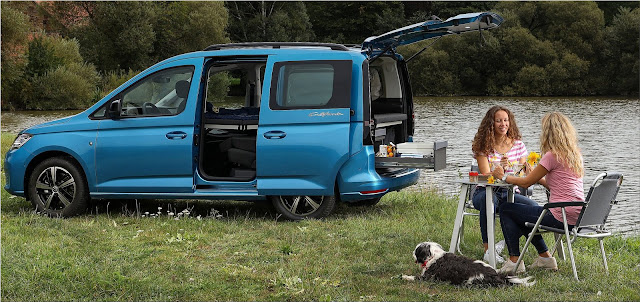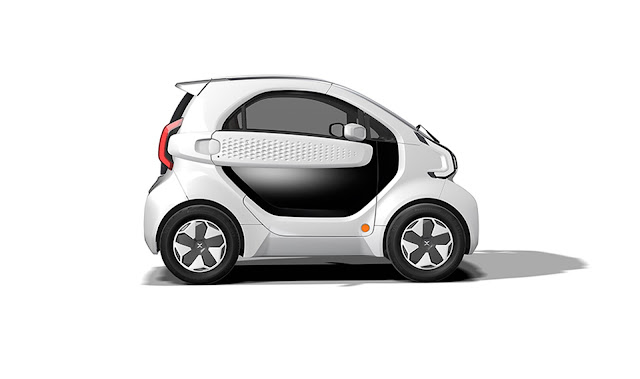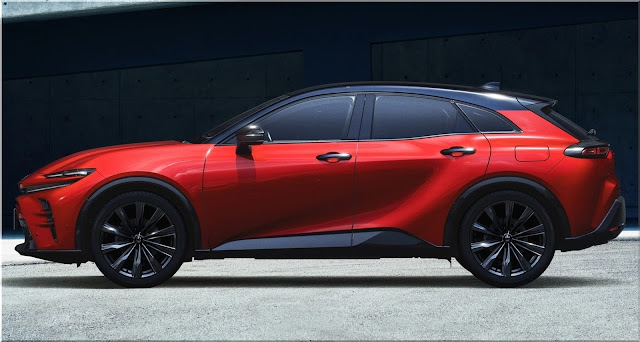Audi activesphere joins the sphere family of concept vehicles, using an electric motor and quick-charging technology
The Audi activesphere is a flexible boundary crosser that blends opposites in perfect harmony, with a drive system and suspension that make it equally adept on and off the road. The steering wheel and pedals enable the driver to actively operate the vehicle while providing autonomous driving for a more pleasant driving experience. It is a coupé with standard dimensions and lines that changes into a pickup for hauling top-class sports gear in only a few seconds - there is even enough space in the cargo bed for two e-bikes.
The concept automobile was conceptualized and designed at the Audi Design Studio in Malibu, just a short distance from the famed Pacific Coast Highway. The project's creative minds are studio manager Gael Buzyn and his staff. "The activesphere is unique," he says of the project's concept. It's a new kind of crossover that cleverly combines the elegance of an Audi Sportback, the utility of an SUV, and true offroad capability."
The Audi activesphere joins the sphere family of concept vehicles, using an electric motor and quick-charging technology from Audi's PPE modular system. It combines the sustainability, dynamics, and long-distance capability of cutting-edge electric cars, with no local emissions, a range of over 600 km, and incredibly fast charging periods thanks to 800-volt technology.
"The spherical concept cars represent our vision for the premium mobility of the future," says Oliver Hoffmann, Member of the Board of Management for Technical Development. We are witnessing a paradigm shift, particularly in the interiors of our future Audi vehicles. The inside becomes a space where travelers can feel at ease while connecting to the outer world. Our adaption of augmented reality for mobility is the most significant technical innovation in the Audi activesphere. Audi dimensions achieve the ideal blend of surrounds and digital reality."
The autonomous chauffeuring capabilities on suitable terrain provide drivers and passengers with a new level of freedom, which, owing to innovative display and operational technology, may be employed in various ways in the activesphere. Audi dimensions, a novel operational idea, merge the actual and virtual worlds (i.e., mixed reality) by presenting digital content in the occupants' fields of vision in real-time.
High-tech headsets show the real area and route while displaying 3D content and interactive components that are uniquely programmable for drivers and passengers.
This implies that all necessary information to the driver, such as driving status and navigation, can be shown. Inside the headset, users can see control panels and other virtual displays in a neat, simple style hidden from untrained sight. Because the headsets display and perform operations by reacting in real-time when users touch them, mixed reality optics allow users to engage precisely with these real, yet invisible, touch-sensitive zones.
The Audi activesphere electric concept car, as a perfect all-rounder, is well adapted to the high needs of a future-oriented generation of Audi customers - people for whom individual mobility and sustainability are not mutually contradictory. Owners who want their vehicle to deliver the brand's signature beauty and dynamism, paired with cutting-edge technology. The Audi activesphere concept is an intriguing vision of traversing multiple dimensions for these clients.
The Audi activesphere idea belongs to the luxury segment due to its proportions of 4.98 meters long, 2.07 meters wide, and 1.60 meters high. The wheelbase is a generous 2.97 meters, typical of an electric vehicle and ensures maximum legroom for occupants. The front and rear overhangs are similarly small, creating a considerably more compact feel than the figures suggest. From every angle, the Audi activesphere concept looks to be made from a single mold.
Large 22-inch wheels, impressive ground clearance, an Audi-typical flat interior, and a dramatic roof arch give the car proportions evocative of a sports car.
The 285/55 tires are large enough for all types of terrain, and their curved tread emphasizes the activesphere's off-road capability. The wheels have moveable pieces that open off-road for maximum ventilation and close on-road for maximum aerodynamics. The two front doors' beautiful, sophisticated camera mirrors are also specifically engineered to reduce drag.
The lack of rigid edges results in soft shadows and smooth transitions between convex and concave surfaces throughout the body. The rear wheel wells seem noticeably horizontal when viewed from the side and rear, demonstrating the concept vehicle's dynamic capability.
Glass surfaces constitute a major portion of the vehicle's body, not simply at eye level. The activesphere's front end has the brand face, the Singleframe, designed as transparent glazing to provide passengers with an unobstructed view of the road in front of the vehicle.
When the activesphere is in off-road mode, the lower door area's glass surfaces on the side appear to melt the border between the natural world and the interior. The wide, curved tailgate has large windows for optimal illumination, and the roof is translucent, allowing enough light into the cabin.
The exterior design emphasizes the vehicle's off-road prowess and, with its massive wheel arches, the variable, electronically controlled quattro all-wheel drive. The ground clearance of the Audi activesphere is also adjustable; excellent for off-road use, it can be increased by 40 millimeters from the standard height of 208 millimeters or decreased by the same amount when driving on-road. When traveling rapidly, this enhances both the center of gravity and aerodynamics. The Audi activesphere has an approach angle of 18.9 degrees and a departure angle of 28.1 degrees, which is important for off-road driving.
The changeable ground clearance is reminiscent of the Audi allroad model family, which has earned an ardent and dedicated fan following in the C and, subsequently, B sectors since 2000. As a notable design feature, this family has air-spring suspension with changeable ground clearance and a noticeably offset floor assembly with underride guard elements since the first iteration. The Avant package option is also important for all allroad variants.
The activesphere is the first vehicle with a Sportback hatchback that blends allroad design components and technical equipment. As a result, Audi refers to the new body variant as the "active Sportback" rather than the allroad.
The Audi activesphere concept is a fresh version of the allroad theme, with dark, high-gloss paint finishes in Arctic Teal on the front and back, as well as underneath the doors in the side region, and matte surfaces that dramatically contrast the floor assembly and cabin. Here, metal strips with slightly offset vertical studs are positioned parallel. These elements appear when the ground clearance increases, indicating that the vehicle is in off-road mode.
The doors of the Audi activesphere, like those of its relative, the Audi grandsphere concept, open in opposite directions and are joined to the A- and C-pillars at the front and rear; there is no B-pillar here either. Because of this innovation, passengers have access to the interior space as soon as they enter the vehicle.
The tiny headlamp units look to be concentrated eyes to the right and left of the Singleframe. By widening and isolating the intersection of two rings to form a pupil - a new, recognizable digital light signature that Audi first unveiled in the Audi grandsphere: the Audi eye - the lighting units replicate the brand's insignia with the four rings. This signature is now varied in the activesphere, with on-road and off-road driving modes, each having their own variant. Daytime running and rear lights employ ultra-fine micro-LED technology for even higher precision and contrast.
Audi activesphere is a boundary-crosser, which implies it is a master of metamorphosis. Its rear segment, in particular, represents its clients' active lifestyles, allowing them to transport even big sports equipment while maintaining the elegance and sportiness of the Sportback shape.
If necessary, the clear rear window slides are practically flat with the Audi activesphere's roof. Simultaneously, the lower, vertical portion of the rear folds horizontally, revealing an expansive luggage bed known as the active back, which has mounts for e-bikes, for example. The rear C-pillars remain in place to maintain the activesphere's dynamic silhouette, while a motorized partition emerges from behind the rear seats to isolate the cabin from the elements.
In the center of the roof structure is a ski rack. It extends if necessary, is completely flush in a nominal position, and is nearly invisible in the roof arch, allowing skis to be safely mounted and carried.
The architecture of the room is dominated by vertical and horizontal surfaces, as well as right angles. The interior zones exhibit horizontal contrasting coloring, with the seating surfaces, door, and front paneling in warm lava red standing out against the black exterior even when viewed via the side windows. Dark colors (black, anthracite, and dark gray) also prevail above and below this core zone.
The four separate seats are suspended like extensions of the central console's high, full-length design. The upper end of the seat shell's inner side is formed horizontally as an armrest and rests on the center console. The designers envisioned the seat, back, and shoulder surfaces as three separate circumferential shells; the outward look offers adequate lateral support. They also appear to float, maintaining the balance between vehicle utility and lounge chair elegance.
When the Audi activesphere concept is driving autonomously, the dashboard, steering wheel, and pedals vanish into thin air. A vast space opens up in front of the driver, especially in the first row of seats, and stretches to the front end of the activesphere. The fully glass Singleframe provides passengers with an unimpeded view of the road ahead for a clear field of vision.
In both the deployed and stowed positions, the dashboard functions as an xlarge soundbar and a clever, full-width air vent. The MMI touchless controls in the doors are constantly visible to the eye and hand and may be used to manage windows and seat adjustments, for example.
The high, full-length center console dominates the architecture and impression of space in the Audi activesphere. Of course, with electric vehicles, the console is no longer required to contain a cardan shaft but instead provides storage and a cooled or heated onboard bar. The top cover is translucent, allowing you to see the bottle and glasses while also aesthetically integrating the large console into the interior. In addition, there is a station in the ceiling, just over the center console and mirroring its dimensions, where all passengers may easily use the four AR headsets for the mixed reality system.
The Audi activesphere concept's strength is in crossing boundaries, which also applies to the interface between the car, the user, and the surroundings. For the first time, the new system blends physical reality and the digital environment to create a new world: the Audi dimensions.
The new system's centerpiece is unique mixed-reality headsets offered separately for each driver and passenger. While in the Audi activesphere, users have access to a rich digital ecosystem.
In the beginning, VR goggles could only show a virtual environment with no real-world aspects. However, technology has advanced to the point where virtual content is superimposed on the real environment. Mixed reality can now present virtual content in three dimensions with spatial references to the actual world. There's no mistake about it: mixed reality will expand the possibilities of AR head-up displays in terms of flexibility, precision, and displayable content in the future.
Audi's activesphere idea is the first to employ a cutting-edge generation of this technology, which adds the dimension of interactivity to the dimension of overlay real and digital worlds. The system brings control surfaces and displays undetectable to the unaided eye into the user's field of view while behind the wheel with remarkable optical precision, maximum resolution, and great contrast.
In other words, the user can examine virtual content that is initially intended for information purposes exclusively. The system displays more detailed information if the user concentrates their eyes on the information, indicating interest. When a user focuses and engages, such as using gestures, content becomes dynamic and interactive.
The hand may then follow the user's gaze to operate automotive functions, while the user interface (the virtual display in the headset) reacts to changes in real-time, just like a traditional instrument. The virtual control advances towards the user, making it possible for them to engage comfortably with the user interface regardless of sitting posture.
The Audi activesphere's neat, spacious interior no longer has to take a back seat to the function of keyboards and scale batteries, as was usually the case with vintage vehicle cockpits. Only when users require it does an element appear, and it can be operated just as naturally as it would in the actual world. Important: The many features of the car are no longer organized in the traditional way that they are in a car with screens and physical functions. They are, nevertheless, logically situated exactly in front of the elements with which they are associated. The AC control hoovers in front of the air vent and the entertainment and sound interactive panel hoovers over the speaker are a few examples.
However, the capabilities of this technology still need to be exhausted. In off-road mode, for example, high-resolution 3D terrain images and navigation and destination information can be projected into the real scene. Traffic safety information, such as notifications for traffic jams or slick roads, can also be used in this context.
Passengers and drivers receive very personalized content in their respective mixed-reality headsets based on their requirements and tasks. Passengers can begin researching and even planning activities at the destination while the driver is concentrating on navigating.
At the same time, they can use the air conditioning to adjust the temperature and air supply for their seating area, as well as explore the music selection of the sound system, which each occupant can utilize individually. The headsets may also project virtual index cards onto the central console to illustrate access to web material because they are precisely tailored to match the shape of the activesphere interior. Because the sensors in mixed-reality headsets detect the interior with millimeter precision, virtual content can be overlaid and even employed for individual interaction.
Even while not in the car, the connection between headset users and the car and its environment opens up a world of possibilities. For example, while navigation routes or vehicle maintenance can be arranged on a laptop or tablet from your living room today, mixed reality technology and the headset will be the only hardware required in the future.
The Audi activesphere idea lends itself to the adoption of Audi's most revolutionary electric drive system, the Premium Platform Electric, or PPE for short, due to its size and performance level.
The activesphere concept, like the related Audi grandsphere and Audi urbansphere concept automobiles, is based on this modular technology for series production. It is being developed in collaboration with Porsche AG, and the first Audi production vehicles based on PPE will be unveiled one after the other before the end of 2023.
The PPE is exclusively developed for battery-electric drive systems and can thus take full advantage of this technology's benefits - for improved driving qualities, economy, and package possibilities.
As a result, Audi can efficiently extend its portfolio of electric vehicles through the high-volume B- and C-segments. Furthermore, economies of scale will allow luxury-class technology and multiple model variations to be combined into an unparalleled portfolio of cars in the premium market.
The PPE is the first platform designed to accommodate an unprecedented range of high-volume automobiles, such as SUVs and CUVs with high ground clearance, as well as cars with a flat silhouette from Audi's core product range, such as the Audi A6 series, whose external dimensions and wheelbase are nearly identical to the Audi activesphere concept.
A battery module between the axles is a significant component of the future PPE fleet; in the Audi activesphere idea, it holds around 100 kWh of energy. Using the entire width of the automobile between the axles allows for a rather level battery layout.
The electric motors on the front and rear axles of the all-wheel drive Audi activesphere concept produce a total output of 325 kW and 720 Newton meters of system torque. A five-link axle connects the front and rear wheels. Audi adaptive air suspension with adaptive dampers is featured on the concept car.
The 800-volt charging tech will be at the heart of all future PPE models' drive technology. This ensures that the battery, like the one in the Audi e-tron GT quattro before it, can be charged quickly at fast-charging stations with up to 270 kW. For the first time, this breakthrough technology will enter the high-volume mid-range and premium markets with the PPE.
PPE technology offers charging durations comparable to a traditional refueling stop for a combustion engine vehicle. Only 10 minutes is required to load enough energy onto the automobile to power it for more than 300 kilometers.
And the 100 kWh battery charges from 5% to 80% in less than 25 minutes. With a more than 600 kilometers range, the Audi activesphere establishes itself as unquestionably suitable for long journeys when necessary.












Comments
Post a Comment